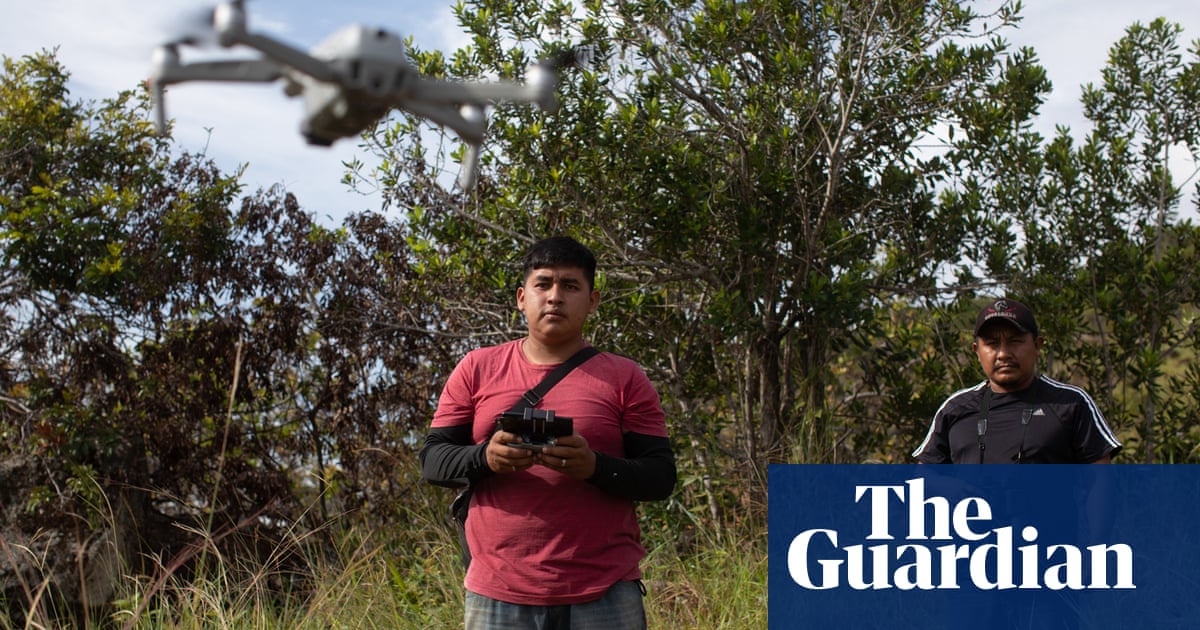The medicine man flashed a mischievous grin as he dabbed his warriors’ eyeballs with a feather soaked in malagueta pepper and watched them grimace in pain. “They’re going into battle and this will protect them,” José Delfonso Pereira said as he advanced on his next target with a jam jar of his chilli potion.
“It hurts and it burns,” the Macuxi shaman admitted. “But it will help them see more clearly and stop them falling ill.”
It was a crisp August morning and a dozen members of an Indigenous self-defence team had assembled in the hillside village of Tabatinga to receive Pereira’s blessing before launching their latest mission into one of the Amazon’s most secluded corners, near Brazil’s border with Guyana and Venezuela.
Some of the men clutched bloodwood truncheons as they prepared to journey down the Maú River in search of illegal miners; others held bows and arrows adorned with the black feathers of curassow birds. Marco Antônio Silva Batista carried a drone.
“If I die, it will be for a good cause – ensuring our territory is preserved for future generations,” said the 20-year-old activist-journalist, whose ability to spy on environmental criminals from above has made him a key member of GPVTI, an Indigenous patrol group in the Brazilian state of Roraima.
Batista, who belongs to South America’s Macuxi people, is part of a new generation of Indigenous journalists helping chronicle an age-old battle against outside aggression. For centuries, non-Indigenous writers and reporters have flocked to the rainforest region to tell their version of that ancestral fight for survival. Now, a growing cohort of Indigenous communicators are telling their own stories, providing first-hand dispatches from some of the Amazon’s most inaccessible and under-reported corners.
“It’s dangerous work and we suffer a lot when we’re out in the field,” said Batista, one of about 26,000 inhabitants of Raposa Serra do Sol, Brazil’s second most populous Indigenous territory. “But it really gives me strength because I’m showing the reality of our lives to the world.”
Brazil’s president, Luiz Inácio Lula da Silva, won power last year promising to improve the reality of Indigenous lives after four calamitous years under the far-right Jair Bolsonaro, who trashed protection efforts and encouraged illegal mining in places such as Raposa Serra do Sol.
Batista and his comrades from GPVTI (pronounced jeh-peh-vi-chee) were among 60 million Brazilians who voted for the leftist. “He’s seen as a brother here … people respect him because he respects Indigenous culture,” the young journalist said of Lula, who authorised Raposa Serra do Sol’s creation in 2005, to the fury of wealthy rice farmers whose henchmen rampaged through one community burning homes, a church and a school.
But Batista had no illusions that Lula’s return to office would miraculously eradicate the threats facing his mineral-rich home, on which diamond and gold miners have long preyed, as well as drug and gun runners. After being cleansed by the shaman, the journalist and his team left GPVTI’s base in Tabatinga on motorbikes and sped east towards the border with Guyana, determined to capture aerial footage of the miners polluting Raposa Serra do Sol’s rivers. They hoped such images may prompt a government crackdown.
“It’s my job to monitor the territory: to see who’s coming in and who is leaving, to find areas being invaded, and to defend the territory because we cannot live without it,” said Batista, who was trained by a local Indigenous association, the Conselho Indígena de Roraima, as part of an initiative called Rede Wakywai, which means “our news” in the local Wapichana language.
Caíque Souza Wapichana, an Indigenous photojournalist who teaches Rede Wakywai’s reporters to use cameras and drones, said he was inspired by a famous 1989 photograph showing a Kayapó activist using a machete to confront the president of a hydropower company plotting to dam a river in another part of the Amazon.
“In the old days we pointed machetes. These days we fly drones,” Souza said, calling unmanned aerial vehicles “defensive weapons” against invaders.


